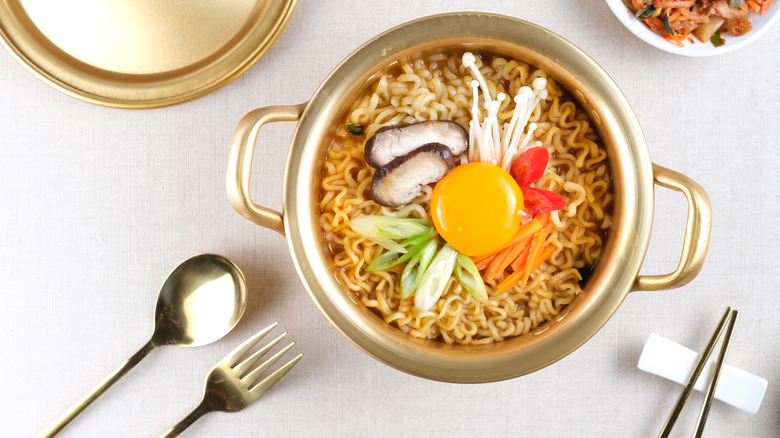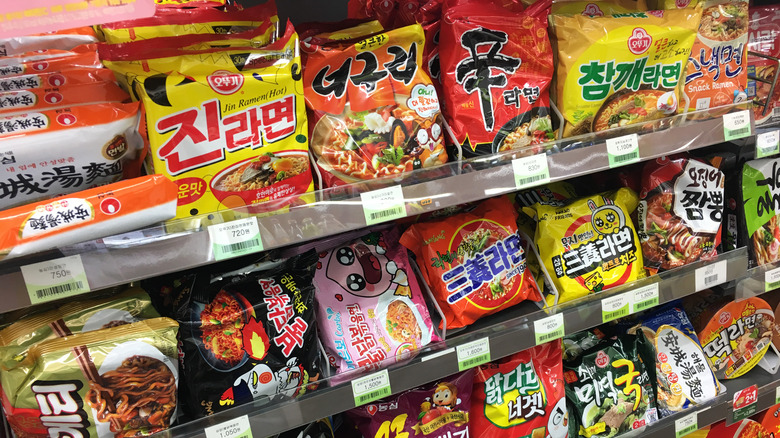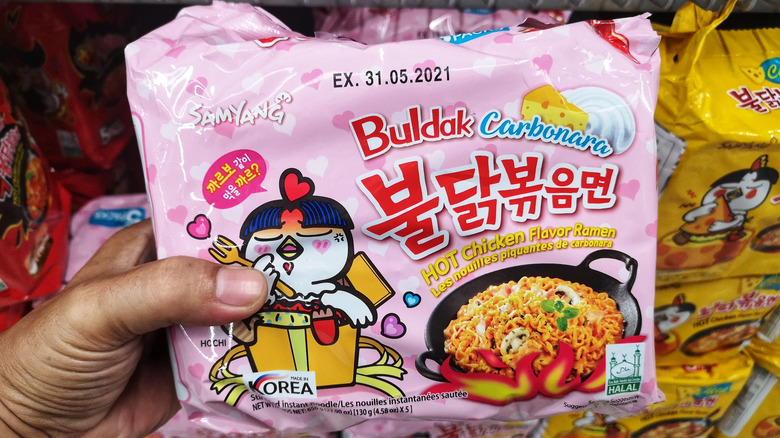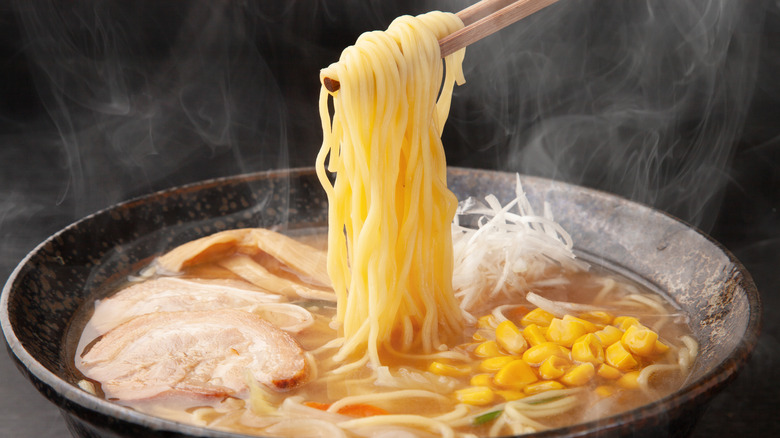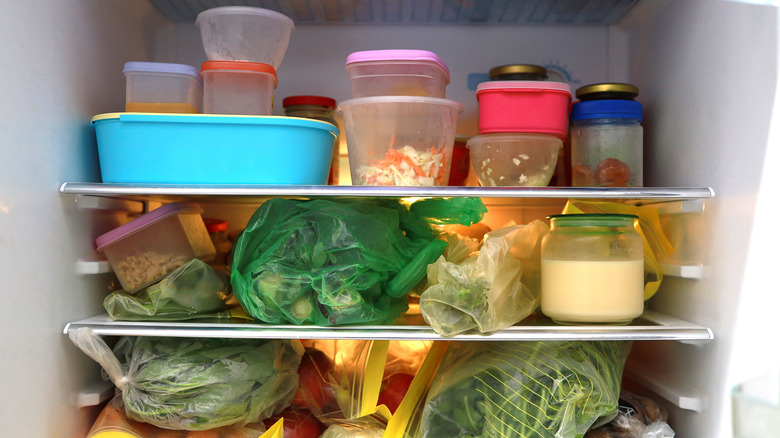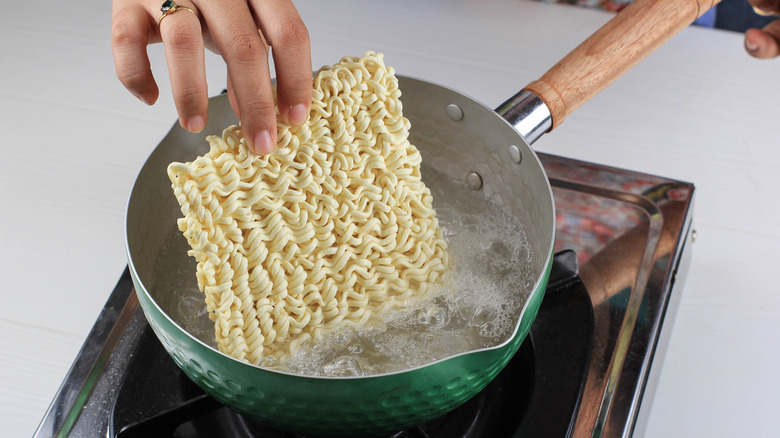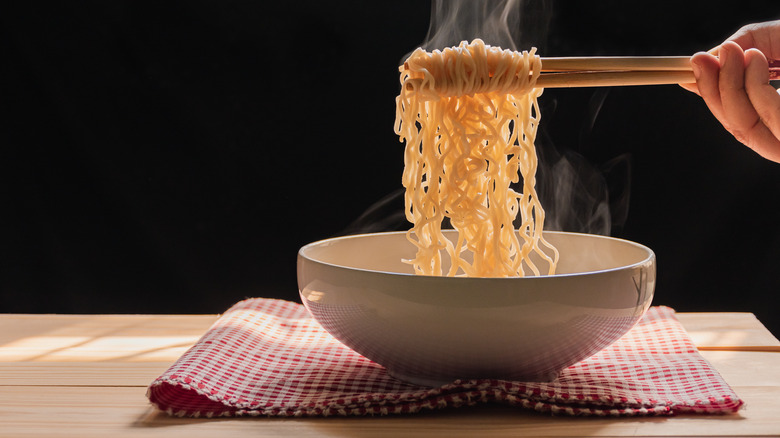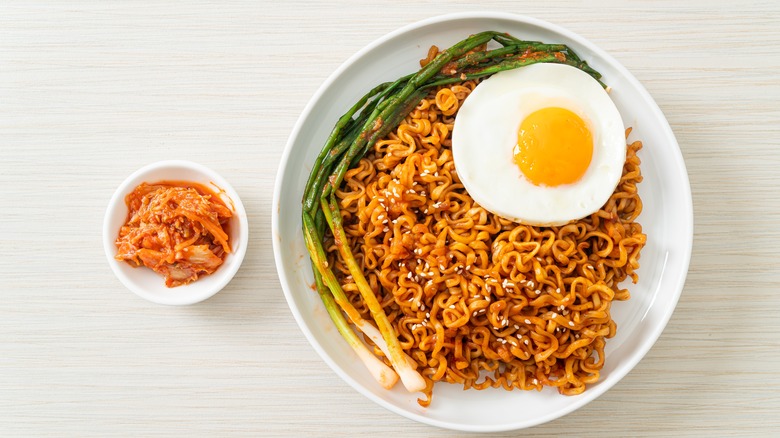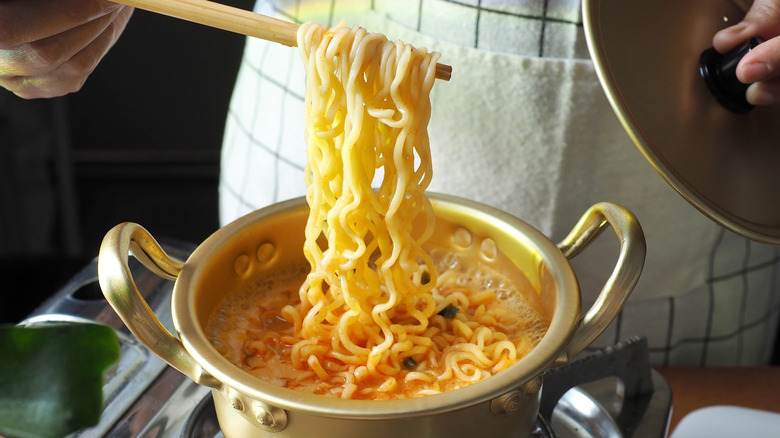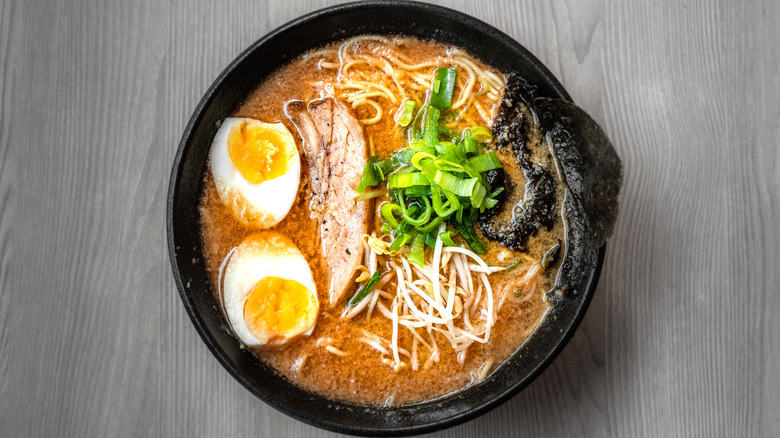11 Mistakes Everyone Makes When Cooking Ramen At Home
There are certain times in life when instant ramen feels like the most perfect food in the universe. Getting home after a night out in the early hours of the morning, tipsy and craving something salty and satisfying, a dark winter's evening when you can't be bothered to cook after a long day at work, arriving back after a long flight and your kitchen cupboards are bare. You rip open the crinkling packet of noodles, steam your face over the boiling water as you hopefully watch them cook, and then slurp up your quite literally instant snack.
As self-contained and delicious as a simple, unaltered packet of ramen can be, however, the world is your oyster when it comes to how to cook them and as such, there are plenty of ways you can screw up making them. And with the World Instant Noodles Association counting that 106.4 billion servings of instant ramen were eaten all over the world in 2019, there's both a lot of potential mistakes to be made. Do you know how long you should be boiling your noodles? Have you thought about adding seasonings and toppings? There's almost no such thing as a bad bowl of ramen, but it's so easy to elevate this humble foodstuff to the level of deliciousness it deserves. Here's how to avoid the most common mistakes that happen when cooking ramen at home.
1. You're buying the wrong kind of ramen
Just because this is an accessible and convenient food doesn't mean you shouldn't carefully consider your choice of noodles. Don't just go for the absolute cheapest brand in the shop because you feel like it's not worth it to spend a few extra pennies on this humble dish. As with any food, there are levels you can explore and different price points to try. We're not saying that the more expensive version is better, but how sad would it be to go through life unknowingly eating a kind of ramen that you later find out isn't your favorite?
It's worth going to a few places to discover the ramen offerings of stores you might not usually visit and scouring the shelves for any packets that catch your eye. Unlike when buying fresh produce, ramen has the distinct advantage of having a longer shelflife. This means that it makes sense to stock up on some different varieties and keep them in your cupboard for rainy days.
2. You're not trying ramen from different countries to discover which you like best
Instant ramen as we know it was originally invented by a Taiwanese-born Japanese man named Momofuku Ando as a way of feeding his then war-torn nation. He perfected his recipe for flash-fried cakes of noodles in his work shed and his product debuted in 1958. By 1963, he was selling more than two million servings a year. Other countries quickly got in on the action, and now you can buy ramen from many different nations across the world.
Why not try Shin ramen from South Korea, Indomie noodles from Indonesia, or Mama noodles from Thailand? Every brand of ramen has its own personality, style, and flavor profile, so eat your way around the world to find out which you like best. It's easy to order ramen online, stock levels permitting, so you shouldn't have any trouble tracking down your new favorites. Of course, you shouldn't miss out on giving Nissin ramen from Japan a try — they're the creators of that original instant ramen we mentioned above.
3. You're sticking to a single flavor
There are as many flavors of ramen as there are stars in the sky. From the more familiar, such as pork, beef, soy and sesame, to the more outlandish, such as cheese curry, ratatouille and sea salt olive oil. Brands often come out with seasonal or special flavors or have limited edition runs and collaborations with other food brands or characters. It's crazy what food science can do, and while all of these types of ramen might look alike initially, with a solid cake of noodles and a few packets of sauces and powders, once you've cooked them up, they all taste completely different.
Don't make the mistake of staying in your comfort zone and always buying the chicken flavor instant ramen when there are so many flavors to enjoy. You can even combine multiple kinds of ramen together to make a dish such as Ram-Don (Jjapaguri), made famous in the Western world thanks to its prominent feature in the best-Oscar winning film "Parasite." This ramen combines two kinds of Korean instant noodles, Jjapaghetti and Neoguri.
4. You're cooking plain ramen, without adding seasonings
This is where things really start getting interesting. It's a huge mistake to think that ramen doesn't need anything added to it apart from the seasonings that come in the packet. Rather, think of this as a base on which to start building a flavor extravaganza. To start off, simply add some ingredients to your ramen that won't affect the cooking time.
You definitely already have a few options in your kitchen and perhaps have just never thought of adding them to instant noodles before. Just a few examples include miso paste, fish sauce, peanut butter, lemon and lime juice, sesame oil, Thai curry paste, Sichuan pepper, chili flakes, vinegar — there are no wrong answers. Experiment according to your taste (but maybe don't add all of the above into the same saucepan). Not seasoning your ramen is an easy mistake to fix when all you need to do is open your cupboard and your fridge and look for ingredients that look as though they might taste good in a bowl of noodles.
5. You're boiling the noodles for too long
If you're throwing your noodles haphazardly into a pot of boiling water and returning a few minutes later to find that they're mushy and dense, this is a mistake that needs correcting. You've probably heard of the Italian phrase "al dente," meaning "to the tooth" to describe the ideal consistency of cooked pasta — perfectly chewy, with a bite to it.
Just like pasta, ramen noodles should be toothsome and satisfying to eat rather than soggy. The Japanese word for this is "shikoshiko." According to Netflix star and chef Roy Choi, two minutes is the perfect amount of time to let your ramen cook. Timings will vary depending on the brand, type of noodle, and even how old they are, so the important thing to remember is always to check the cooking time on the packet and start tasting a couple of minutes before you think they'll be done. This way you'll get perfect, chewy noodles every single time.
6. You're not experimenting with the order of operations
We've all had that humbling moment of fishing an empty packet out of the recycling to double-check the cooking instructions of something you thought you knew how to cook. But never with ramen, right? Everyone knows that you boil the noodles, drain them, dump in seasoning powder and stir? Wrong! While there's nothing wrong with this traditional method, it's worth experimenting to find the cooking style that works the best for you.
A recipe popular on TikTok, for example, has you cook the noodles and mix the seasoning packets with an egg, mayonnaise, and garlic in a separate bowl, then stir everything together off the heat. This produces much creamier ramen than usual. You could also try increasing or decreasing the amount of water you use, for a more or less soupy version of ramen, or try mixing the seasoning into the water as it boils to deeply infuse the flavors into the noodles. When a dish is this easy to make, it's very hard to mess it up, so experiment freely and without fear!
7. You're not dreaming big enough with your add-ins
A bowl of ramen doesn't just mean a bowl of noodles. Add chicken, tofu, tuna, cheese, or whatever kind of protein your heart desires to make a more fulfilling plateful. To keep this a speedy meal, it can be helpful to use pre-cooked proteins as opposed to raw — if you're starving hungry and counting the minutes until your noodles are ready to slurp, you're not likely to want to wait for a chicken breast to cook from scratch.
Eggs are a great option for this reason alone. You can crack an egg straight into an almost-ready pan of ramen and feel confident that your protein requirements for this meal are being fulfilled. Ramen is also the perfect vehicle for sneaking extra vegetables into your diet and with the delicious broth you're crafting, you'll barely be able to tell that you're eating a Popeye-esque quantity of spinach. You can either use quick-cooking vegetables that you add to the same pan you cook your noodles in, such as fast-wilting greens, peas, or bean sprouts, or cook them separately and add at the end, such as broccoli, cauliflower, and carrots.
8. You're using a fork, or disposable chopsticks
Okay, so a fork is a perfectly serviceable implement to use to eat your ramen, but it's not how it was designed to be eaten. Chopsticks are the perfect tool for gripping your ramen noodles and lifting them out of the bowl into your mouth with minimal slippage, and for grabbing those toppings too. Invest in a pair of reusable chopsticks that you like and use them. With China alone getting through 40 billion disposable chopsticks a year, don't add to the waste by using utensils that you know you'll throw away after your meal. Plus getting your own chopsticks means you can choose a cute pattern and design that you like, and can use them indefinitely for years to come.
One important point to note, however, is the positioning of your chopsticks once you've finished your ramen. In Japanese culture it's exceptionally bad luck to place your used chopsticks inside your bowl, as it imitates a funeral ritual in which chopsticks are stood upright in a bowl of rice. Outside of this content, it's said to bring bad luck. Place chopsticks next to your plate or along the rim of your bowl instead.
9. You're letting the ramen cool off too much before diving in
We're not saying you should burn your tongue in your haste to slurp your noodles, but not eating your ramen when it's piping hot is basically a crime. Apart from the fact that food that should be served hot is never as good once it's allowed to cool down, waiting to eat could ruin the texture of your noodles.
According to ramen expert and chef Ivan Orkin, a New Yorker who ran two highly successful ramen joints in Tokyo, you have only a short window to eat your ramen before your noodles start to lose their deliciousness. Letting cooked noodles sit around in a hot broth means they start to release their starch, making everything mushy and upsetting the delicate balance between noodles, soup, and toppings. Taking Orkin's advice to eat your noodles right away shouldn't be difficult to do when you've used all of our tips to create an exceptionally well-seasoned and perfectly cooked bowl of noodles.
10. You're not considering your beverage options
One of the advantages of ramen is its adaptability, and this goes for accompanying drink options as well. Before we get to the more exciting drinks options, make sure to grab a glass of water to sip as you eat your noodles. Instant ramen is pretty high in sodium, often hitting up to 70% of your daily allowance, and will leave your mouth feeling like the Sahara desert if you don't ensure that you're well hydrated.
Beer is a classic choice, with the flavors complementing the salty savoriness of the noodles, and the light carbonation helps make everything feel light. Surprisingly enough, wine is also a popular option. If this appeals, try choosing your wine depending on the flavors and toppings you're using. Pinot Grigio is a wine whose body and light sweetness match well with most types of ramen. Tea could also be a good match if you don't want a drink that contains alcohol. In Korea, barley tea is often drunk as an accompaniment to meals, and it's even thought that it could help with digestion.
11. You're too polite when eating your ramen
Ramen should be slurped noisily and that's all there is to it. This isn't the moment to be shy, and there are genuine reasons why it's recommended. Slurping your noodles helps them to cool down faster, meaning they're less likely to become mushy because they've sat in your bowl for too long. According to Discover Magazine, aerating the noodles also helps to enhance the flavor of the ramen, as it means you're using all five senses to enjoy your bowlful. There's even evidence that says that slurping increases the amount of oxygen in your mouth as you eat, positively changing the flavor of the food. So go ahead and slurp away with enthusiasm. There's nothing quite like getting a face full of aromatic steam as you bend over your bowl of noodles. Slurping increases the sensory nature of eating and is perfectly acceptable — nay, encouraged! — in Japan.
